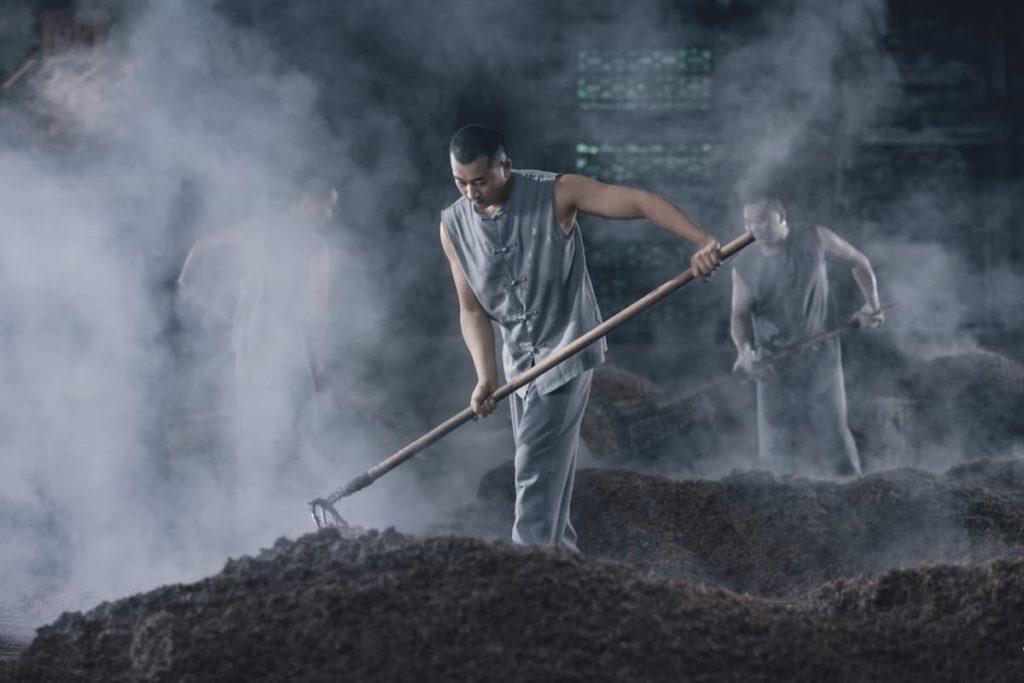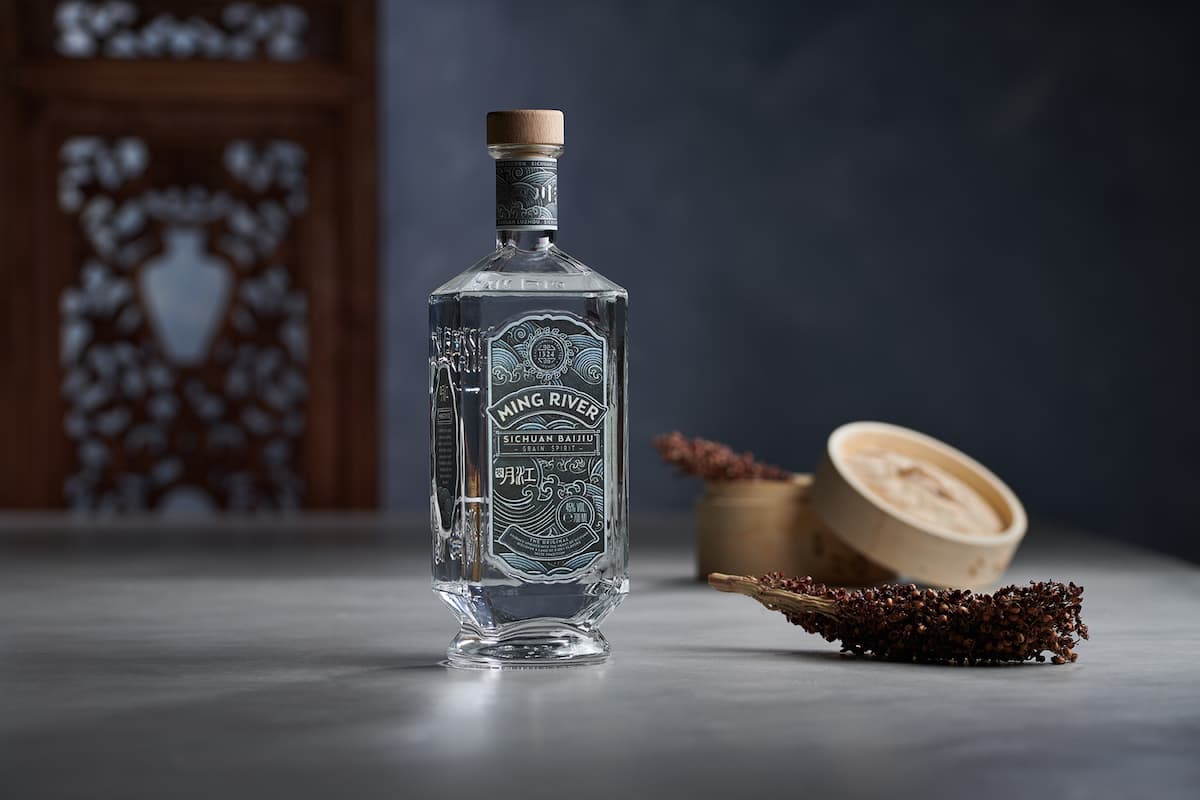With drinkers becoming increasingly accustomed to boldly flavored beverages like mezcal and amaro, perhaps it’s time to take a closer look at the Chinese spirit baijiu. Like these other categories, baijiu (pronounced “bye joe”) can be challenging at first taste, but the more you know about it, the easier it is to love. At least that’s what happened to me.
Most of the information about the category I’ve written below comes from the book Baijiu: The Essential Guide to Chinese Spirits by Derek Sandhaus, as well as from what I learned on a press trip to the Luzhou Laojiao distillery in Luzhou, China, where Ming River Baijiu is produced.
The term “baijiu” covers all Chinese distilled spirits, all of which are fermented with “qu,” a mix of grains embedded with yeast, mold, and bacteria. If you’re familiar with sake, you’ll know that koji is a mold that breaks down the complex carbohydrates in rice into fermentable sugars that are then fermented by yeast. Qu works similarly; it’s just all bound up together with yeast and spread into the grains all at once.
Like whiskey, baijiu is fermented and distilled from grains. The most common grains used are sorghum and rice, though corn, barley, wheat, and other grains are employed depending on the category and brand.
Baijiu’s Four Main Categories
There are four main categories of baijiu, called “aromas,” though it’s easiest to think of these as styles of spirits and ignore the idea of odor. These were originally regional styles of baijiu that become formalized over time. Thousands of small individual distilleries were grouped together into fewer larger ones, and the government created official styles usually based on the dominant brand from each region.
The category of “sauce aroma” baijiu includes the top-selling and most famous brand Kweichow Moutai. It and other sauce aroma baijiu do taste intensely like savory soy sauce (except not salty), with rich umami notes in flavors (in my opinion) of savory mushrooms and dark gamey meats like venison. They are rich and intense.

The top-selling category of baijiu (about 75 percent of sales) is “strong aroma” baijiu. Brands of strong aroma baijiu include the National Cellar 1573 brand and Ming River, both from parent company Luzhou Laojiao; Wuliangye; and Shui Jing Fang that is owned in part by Diageo. To me, strong aroma baijiu often tastes like a combination of bright tropical fruit, soft creamy cheeses, and earthy barnyard notes. It can seem unrestrained at first, as if something in fermentation had gone horribly awry, until you learn to appreciate that all the strong flavors are very much on purpose and each product is blended to taste exactly as it does.
“Light aroma” baijiu is known for short production cycles with minimal aging periods. It has a light body with floral notes and the sweetness and flavor of dried fruit. “Rice aroma” baijiu is distilled from fermented rice as you might guess, and is sometimes made in column stills. It has a light body like vodka, with notes of flowers and honey. There is a brand of rice aroma baijiu, Vinn, made in Oregon.
Continuous Fermentation and Redistillation
Rather than fermenting and distilling a sugary liquid (as with scotch whisky and rum) or a slurry of liquids and solids mixed together (as in bourbon), baijiu ferments and then distills moistened grain solids. The only other spirit I can think of that’s fermented and distilled from a solid is grappa.
Grains for baijiu are steamed, mixed with qu, covered, and then put into the fermentation pits or pots. Depending on the style, fermentation can last for multiple months to build up flavor. Then the moist, fermented grains with alcohol sticking to them are put into pot stills. The stills are built like bamboo steamers—steam pumped from below the grain solids helps lift the alcohol up out of the grains, and it is collected and condensed as in a typical pot still.
Here’s where it gets even stranger: For strong aroma and sauce aroma baijiu, after the grain solids have been distilled, they are scooped out of the still and placed back into their fermentation pits or vessels to ferment again, along with some freshly-steamed grains that have not yet fermented, and additional qu. The fermentation vessels now contain both previously-fermented and unfermented grains.

In sauce aroma baijiu, this refermentation with added fresh grain happens a couple times out of eight cycles of fermentation; during the rest of the cycles, the same distilled grains are refermented and redistilled with no added unfermented grains. After the grains are refermented and redistilled for eight cycles over a one-year period, the process is complete. The various distillation runs are aged in ceramic vessels separately, and then blended together to make the final products.
In strong aroma baijiu, previously distilled grain is mixed with freshly steamed grain in every fermentation cycle. In strong aroma baijiu the goal is to never stop the cycle of mixing some of the last batch’s distilled grains in with the new grains, in the same fermentation pit as last time. And by never stop, I truly mean never. The continuous use and total age of the fermentation pit is considered a great point of pride and quality in baijiu.
The goal is to keep reusing the same fermentation pits that build up bacteria in the walls, making for increasingly complex, aromatic spirits with each cycle. There are non-exact parallels to sour mashing and to stillage used in Jamaican rum, and to using wooden fermenters to make certain spirits rather than sterile stainless-steel ones.
The four original fermentation pits used for National Cellar 1573 brand baijiu have been used continuously since the year 1573 (that’s 450 years!) according to the brand. They also use many pits over 100 years old, and the oldest ones are considered the best to make the most aromatic, intense flavors for baijiu.
Distilled baijiu is aged in non-reactive ceramic vessels (sometimes in stainless steel), and it’s blended between younger and older and more and less flavorful batches to make individual brands. The final product can range anywhere from a fresh, light, and fruity rice aroma product to a pungent, meaty sauce aroma baijiu.
In its home country, baijiu is most often consumed with food, with drinkers taking tiny sips between bites, particularly when eating spicy Sichuan food. If you want to ease into the category, that’s the way I’d recommend trying it. And I do recommend trying it. Baijiu is an amazing spirit.



